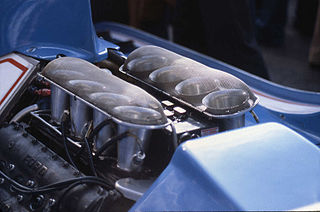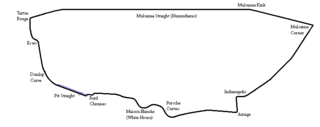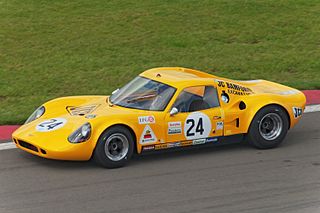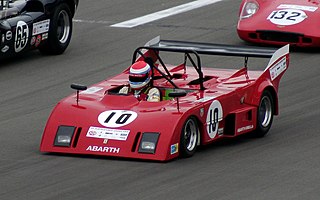
The DFV is an internal combustion engine that was originally produced by Cosworth for Formula One motor racing. The name is an abbreviation of Double Four Valve, the engine being a V8 development of the earlier four-cylinder FVA, which had four valves per cylinder.

The Mirage Lightweight Racing Car was a family of race cars built by J.W. Automotive Engineereing (JWAE) at Slough in England, initially to compete in international sports car races in the colours of the Gulf Oil Corporation.

The 1972 24 Hours of Le Mans was the 40th Grand Prix of Endurance, and took place on 10 and 11 June 1972. It was the ninth round of the 1972 World Championship for Makes.

Ecurie Bonnier, Ecurie Suisse, Joakim Bonnier Racing Team and Anglo-Suisse Racing Team were names used by Swedish racing driver Joakim Bonnier to enter his own cars in Formula One, Formula Two and sports car racing between 1957 and his death in 1972. Commonly the vehicles were entered for Bonnier himself, but he also provided cars for a number of other drivers during the period.

The Lola T290, and its evolutions, the T292, T294, T296, T297, T298, and T299, are a series of Group 5 Sports 2000 prototype race cars, designed and developed by Bob Marston, John Barnard, Patrick Head, and Eric Broadley, and built by British manufacturer and constructor Lola, for European 2-Litre Championship sports car racing series, between 1972 and 1981.

The Chevron B21 is a 2-liter Group 5 sports prototype race car, designed, developed and built by British manufacturer Chevron, in 1972. Over its racing career, spanning 13 years, it won a total of 23 races, scored 45 podium finishes, and clinched 11 pole positions. It was powered by a naturally-aspirated 2.0 L (120 cu in) Ford-Cosworth BDG, or BMW M12/7, four-cylinder engine, both making around 275 hp (205 kW). Only 28 cars were built.

The Chevron B23 is a Group 6 sports prototype race car, designed, developed and built by British manufacturer Chevron, in 1973. Over its racing career, spanning 12 years, it won a total of 12 races, scored 41 podium finishes, and clinched 2 pole positions. It was powered by a naturally-aspirated 3.0 L (180 cu in) Ford-Cosworth DFV Formula One engine, producing 398 hp (297 kW).

The Chevron B8 is a lightweight sports racing car, designed, developed and built by British manufacturer Chevron Cars, in 1968. It is homologated in the Prototype category of the International Automobile Federation.It won thirty-six races during her various engagements. Only 44 cars were built.

The Ligier JS3 is a sports-racing car that was built by Automobiles Ligier. It was unveiled in 1971 and ended its competition life in the same year. Only one JS3, chassis JS3-01, was ever built.
Maserati has made three inline-4 racing engines, that were designed for both Formula One and Sports car racing. Their first engine was the supercharged 4CLT engine in 1950; with the 1.5 L engine configuration imposed by the FIA for engines with forced induction. Their second engine was the naturally-aspirated 250S engine; with the 2.5 L engine configuration, and was used by Cooper and JBW. Their third and final engine was the naturally-aspirated Tipo 6-1500; with the 1.5 L engine configuration, and the customer engine was used by Cooper, Emeryson, Lotus, and E.N.B. teams.

The Toyota R32V and R36V engine family are a series of turbocharged, 3.2-liter and 3.6-liter, 90-degree, four-stroke, V-8, gasoline racing engines, designed, developed and produced by Toyota for sports car racing; between 1988 and 1999. The engines were used in various Toyota sports prototype race cars.

The Abarth-Osella PA1 is a 2-liter Group 5 prototype racing car built by Osella in collaboration with Abarth, to compete in the World Sportscar Championship sports car racing series in 1973, but was used in active competition through 1982.

The March 84G was a mid-engined Group C and IMSA racing sports prototype, designed and developed by March Engineering in late 1983 and used in sports car racing until 1989. It was powered by a number of different engines, including a Chevrolet small-block, a Buick V6, a Porsche flat-six, and even a Mazda 13B Wankel rotary engine. Power output was around 620 hp (460 kW). It only managed to score 5 wins, and clinch a total of 10 podium, over the course of 7 years and 119 race entries.

The Courage C30, also known as the Courage C30LM, was a Group C2 sports prototype, designed, developed and built by French manufacturer Courage in 1993. It famously contested in the 1993 24 Hours of Le Mans, with drivers Derek Bell and Pierre Yver finishing in 10th and 11th place, respectively.
The Inaltera GTP is a Group 6 sports prototype race car, design, developed and built by Automboiles Jean Rondeau in 1976. It competed in sports car racing between 1976 and 1978. Its best result was a 4th-place finish at the 1977 24 Hours of Le Mans, and it won 3 races in its class. It was powered by a 3.0 L (180 cu in), 415 hp (309 kW), Ford-Cosworth DFV V8 Formula One engine.The chassis is an aluminum-reinforced steel multi-tubular spaceframe, covered in a fiberglass panel body. This drove the rear wheels through a Hewland L.T. 200 five-speed manual transmission. This meant it was very light, with the total weight coming to 815 kg (1,797 lb).

The Chevron B16 was a Group 4 sports prototype race car, designed, developed, and built in 1969 by the British racing car manufacturer Chevron Cars as a two-seater racing sports car for the makes world championship. Brian Redman won the very first outing, the 500 km (310 mi) race at the Nürburgring on September 7, 1969, at a time of 3:13:01.6 hours. The last victory with a Chevron B16 was achieved by Clemens Schickentanz on July 11, 1971, in the sports car race at the Norisring.

The TOJ SC03 is a 2-liter sports prototype race car, designed, developed and built by German racing team and constructor, Team Obermoser Jörg; constructed to the FIA's Group 5 category and specification of racing, specifically the European 2-Litre Sportscar Championship, in 1975. Its career spanned 5 years (1975-1979), and in that period of time, it won a total of 3 races, and scored 9 podium finishes; as well as one pole position. It was powered by a naturally-aspirated 2.0 L (120 cu in) BMW M12/7 four-cylinder engine; producing 300 hp (220 kW).
The March 82G is a IMSA GTP/Group C sports prototype race car, designed, developed and built by British manufacturer and constructor March Engineering, for sports car racing, in 1982. It competed in motor racing between 1982 and 1986, but only scored 1 race win, 8 podium finishes, and 2 pole positions. It was powered by a naturally-aspirated 620 hp (460 kW) 5.7 L (350 cu in) Chevrolet V8 engine.

The Lola T210, and its evolution, the Lola T212, are Group 6 sports prototype race cars, designed, developed and built by British manufacturer Lola, for the newly created European 2-Litre sports car racing championship, in 1970.
The Lola T220, and its evolution, the Lola T222, are Group 7 sports prototype race cars, designed, developed, and built by the British manufacturer and constructor Lola, to compete in the Can-Am championship from the 1971 season. It also took part in the European Interserie championship.



















